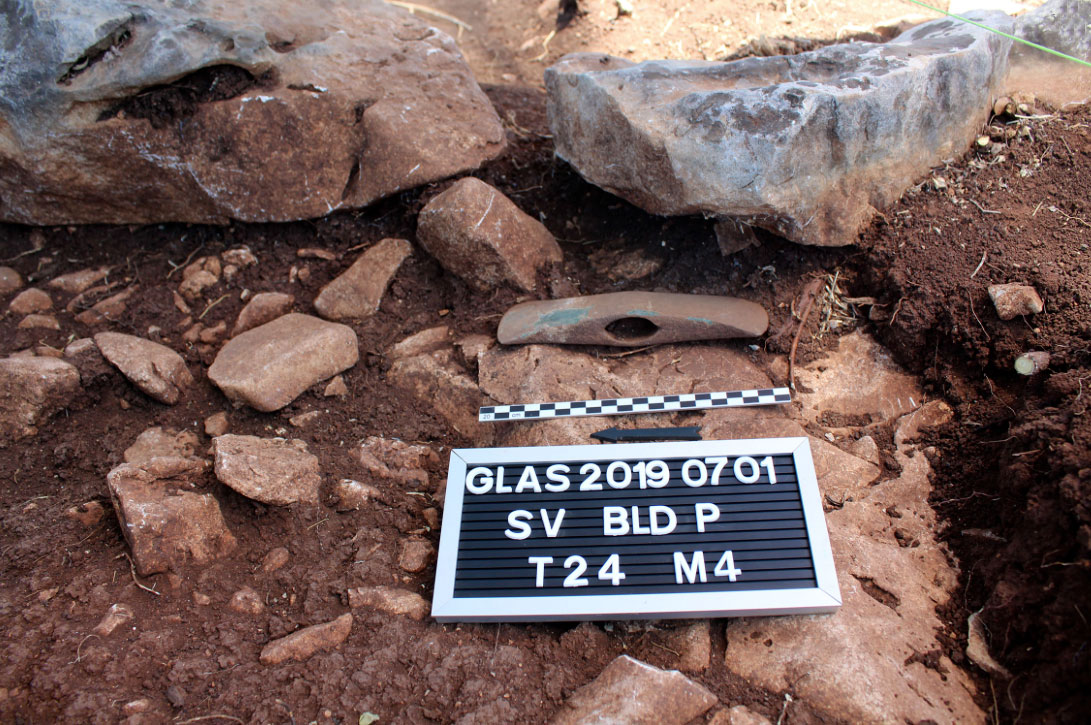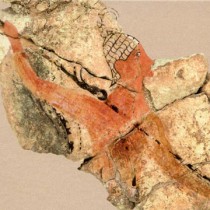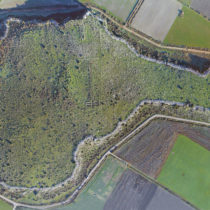In Boeotia of the 13th century BC one of most impressive technical works of Greek prehistory was carried out: the draining of lake Kopais so as to create new land for agriculture/cultivation. As was to be expected the region’s “topography” changed. Glas’ steep rock, protruding like an islet in the northeast corner of the lake, not only became accessible via the drained, fertile plain that was formed, but it was inhabited and fortified with a strong cyclopean wall 3 kms long, creating the Mycenaean acropolis of Gla. Its area of over 49 acres makes it the largest conserved Mycenaean acropolis in Greece.
The new excavations that started the last two years at Gla reactivated research in the region resulting in new important architectural remains coming to light: five large new building complexes‒separate or in clusters, distinguished for their symmetry and arrangement on an axis‒and movable finds found in the above places, All date from the peak of the Mycenaean civilization, around 1250 BC.
Are these building facilities related with the draining works of the lake? “Definitely” says research director Dr Elena Koundouri, head of the Directorate of Prehistoric and Classical Antiquities of the Ministry of Culture and Sports/MOCAS to the Athens and Macedonia News Agency. And continues: “To begin with, after researching the drainage works, we now know very well that they are chronologically related. That is, around 1300/1250 BC both the drainage works were constructed, the acropolis was fortified and these big buildings erected. Moreover, in that same period other sites around the lake were fortified and inhabited, i.e. Agios Ioannis and Agia Marina. I believe that it is some single construction project probably realized by Orchomenos as the region’s big palace centre. In other words, it makes the drainage work, fortifies Gla and a series of other sites, to control the plain on the one hand with its agriculture established after the drainage and on the other hand to manage all this wealth being produced”.
Scientific queries remain, however. “What we still cannot understand are the details of Gla’s relations with Orchomenos. Is it a secondary palace centre, its satellite? We still cannot explain its role. This is why we have restarted the research so as to answer a series of similar questions; in the light of course of other research meanwhile undertaken in the region, to work within the framework of all the sites in this northern part of Kopais” explains Ms Koundouri to the AMNA.
In other words, one research step has led to another. “All the sites are very close to one another, very near Gla and highly visible. Gla was at the end of this speculation and the ‘journey’and we had to return to it little by little so as to explore the rest of the area” says the excavator regarding the pieces of the puzzle gradually being put together in the region. And how much of the area remains to be explored on the Gla acropolis? “A very large piece. The architectural remains have been located in a small part of the south west section. The rest are yet to be researched” says the excavation head to the AMNA, stressing that the whole venture “requires extensive clearing, field walking, geophysical prospection and then gradually you learn both to recognize the site and to locate the buildings. We have only managed to work on a small piece till now. The rest will be researched in due course”.
Movable finds were also located inside the large buildings on the Gla Acropolis , such as typical vases of the Mycenaean era, fragments of wall paintings, lead vessels and sections of anthropomorphic Mycenaean statuettes artefacts which, according to the Ministry of Culture and Sports’ statement, confirm “the existence of a familiar, common cultural and artistic tradition during the times of a very wide spread Mycenaean expansion”. Among the finds was a rare, intact bronze double axe. How did the team feel when they found it? “We had a field day! it was a most impressive find, this year’s highlight”, said Ms Koundouri emphatically to the AMNA, adding that it is a utilitarian object only slightly used, as was shown when cleaned and studied by an expert on the interdisciplinary team participating in the research.
“Bronze objects are rare because bronze is a valuable material. They often hide it and then reuse it, treasures (assemblages of precious objects) of bronze have been found from this period in Mycenaean Greece. At Gla we do not have another such find neither in the region at large; only a slightly later treasure from Orchomenos” explains Ms Koundouri to the AMNA, adding that the double bronze axe of Gla was found with other artefacts, such as a lead utensil and stone tools. “The axe had barely been used because they had obviously abandoned the settlement afterwards. Perhaps they hid it near the floor so as to find it when they returned, but this did not happen and so it got to us”, she concludes.
The systematic excavations on the Gla Acropolis are conducted as part of a five year interdisciplinary archaeological project (2018–2022) realized by the Archaeological Society of Athens, under Dr Helen Koundouri in close collaboration with the Boeotia Ephorate of Antiquities and the support of the Orchomenos Municipality and the Parish of Panaghia Scripous.





